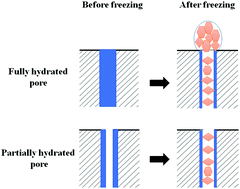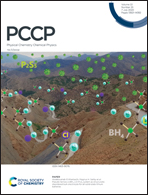Evolution of confined ice nano structures at different levels of pore filling: a synchrotron based X-ray diffraction study†
Abstract
We have thoroughly investigated the crystal structure of ice evolved from super cooled water confined in MCM-41 cylindrical nano pores through a synchrotron-based X-ray diffraction (XRD) technique for two different levels of pore filling. A rigorous analysis of XRD data shows that the nucleation dynamics and the structure of nucleated ice highly depend on the level of pore filling. In the nearly fully hydrated pores, ice crystallites start nucleating inside the pores below 240 K and creep out of the pores to form bulk crystals having crystalline structure of a mixed phase of hexagonal and cubic forms. In the partially hydrated pores, on the other hand, ice crystals cannot creep out of the pore crossing the energy barrier. The crystalline ice particles remaining inside the cylindrical pore show a short range “cubic rich” structure. The “pure cubic” phase has not been identified at either of the pore fillings in these 2.5 nm average size pores. A large fraction of water inside the pores remains in the super cooled liquid phase even at 180 K. This observation is relevant for understanding the ice nucleation through the pore condensation and freezing mechanism, which is a major pathway for the formation of cirrus clouds in the upper atmosphere.



 Please wait while we load your content...
Please wait while we load your content...